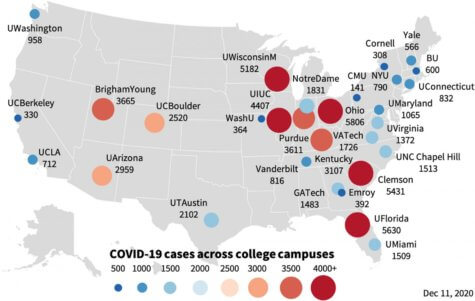STANFORD, Calif. — A troubling new study finds the first two weeks of college semesters represent a serious viral challenge in terms of containing the COVID-19 pandemic. Researchers from Stanford University say college campuses could be so-called “superspreaders” responsible for upticks in coronavirus cases throughout their entire local county.
Study authors examined 30 U.S. college campuses with the highest numbers of reported cases. Over half of those schools experienced major infection “spikes” well above 1,000 coronavirus cases per 100,000 people on a weekly basis during the first two weeks of the semester. By the end of the fall semester, one in five students attending certain schools tested positive for COVID-19. Moreover, among 17 of the analyzed campuses, a new computer model shows campus-specific outbreaks coincided with peak infection rates in the entire local county.

While all that sounds pretty bleak, researchers also stress that strict health measures such as a full transition to online learning can reduce viral peaks within about two weeks.
“Policy makers often use an incidence of 50 COVID-19 cases per 100,000 people per week as a threshold for high risk counties, states, or countries. All 30 institutions in our study exceeded this value, three even by two orders of that magnitude,” explains lead author Hannah Lu, from Stanford’s Energy Resources Engineering program, in a release. “The number of students who had become infected just throughout the fall is more than twice of the national average since the beginning of the outbreak of 5.3%, with 17.3 million reported cases at a population of 328.2 million.”
“At the University of Notre Dame, for instance, all 12,607 students were tested before the beginning of class and only nine had tested positive. Less than two weeks into the term, the seven-day incidence was 3083, with a reproduction number R0 of 3.29,” she adds. “However, with around 90 reported deaths nationwide, mainly college employees and not students, the campus-related death rate of 0.02% remains well below the average death rate of COVID-19.”
The timeframe for this study was fall 2020. All included colleges had resumed classes at that time, either via in-person classes, remote learning, or a combination of both.
“Strikingly, these local campus outbreaks rapidly spread across the entire county and triggered a peak in new infections in neighboring communities in more than half of the cases,” senior author Ellen Kuhl notes. “It is becoming increasingly clear that these initial college outbreaks are unrelated to the national outbreak dynamics. Instead, they are independent local events driven by campus reopening and inviting students back to campus.
“Our results confirm the widespread fear in early fall that colleges could become the new hot spots of COVID-19 transmission. But, at the same time, college administrators should be applauded for their rapid responses to successfully manage local outbreaks,” she continues.
All of the colleges involved in this study kept close track of daily case rates and even initiated regular surveillance testing and test-trace-isolate strategies. Consequently, the colleges themselves did a fairly good job of containing outbreaks. The surrounding counties, though, didn’t fare as well.
“The majority of colleges and universities were able to rapidly manage their outbreaks and suppress campus-wide infections, while the neighboring communities were less successful in controlling the spread of the virus. As a result, for most institutions, the outbreak dynamics remained manageable throughout the entire fall of 2020 with narrow spikes of less than 300 cases per day,” Lu states.
“We anticipate that the most important aspect upon campus reopening within the coming weeks will be the human factor. Unfortunately, the fall term has shown that the best of all strategies can become meaningless if people do not follow the recommendations,” Professor Kuhl concludes.
The study is published in Computer Methods in Biomechanics and Biomedical Engineering.
